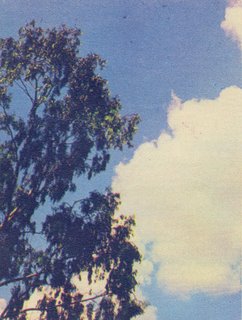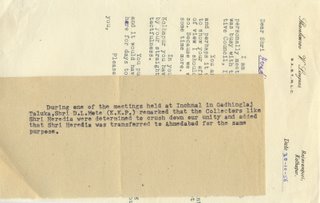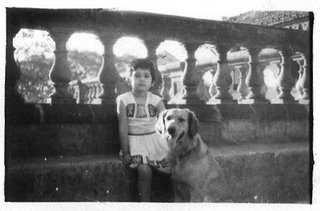scribendi cacoethes
LULLABY

Sitting in the sun
On an afternoon in May
Under the trees
In whose boughs the breeze
Wakens the surge and murmur of the seas.
Watching the sky
Pale, changeful as clear pools where
Sun, shadows and the waving seaweed play.

Clouds flow, formless and light. Far away
Tall tree-tops rise, dip and sway
Graceful as galleons on the Main.
Music and slow movement ease
With sleep the twisting brain,
Lapped by the salt waves in the vein,
Slow-welling peace
Flows from the life in sky and seas.
©1985 by Ruth Heredia

Journal Jottings
~ "Federer will find a way to praise himself and still seem saintly...(Rohit Brijnath, writing in the Hindu of 19 July)"
Aha! Wondered when someone would notice - & speak up!
Amusing cartoon in the Deccan Herald of 20 July commenting on the blog-blundering of the Government has uniformed goons casting “govt.net.in” as they chant “Block! Block!” which inevitably turns into “Blog! Blog!” Elementary but enjoyable.
CUISINART
The White Knight’s Marmalade“It’s my own invention” [Lewis Carroll: Through the Looking Glass]
Very Important Preliminary Notes:
I have only used Kino fruit. This curious orange coloured fruit is called Kino when grown in Himachal Pradesh and sold by an unpretentious fruiterer. That may even be its correct name. But the fancy fruiterer, who makes his profits from snobs, will call it a Malta and inflate its price. What matters to you is only that the skin of the Kino/Malta should be blemish-free and clearly indicate freshness. The skin of fresh fruit gleams with moisture and with its essential oil – the much-prized, distinctive, aromatic citrus oil. Old fruit has less pectin. Less pectin will seriously compromise your marmalade.
Whatever its true name, or its place of origin, this is an exasperating fruit. Until you cut each one there is no knowing what you will find; and what that is has consequences for which you must be prepared. I have made three batches within a month, each different. The middle batch had to be converted – rather successfully – into orange chutney…..
Here goes.
* Some fruit has thick rind. This is excellent. Thick rind = more pectin and more water absorbed; thin rind = the undesirable opposite. Some fruit is very sweet, some very sour, some between sweet and sour, at calibrated distances from the one or t’other. Now, sweet fruit will not ask for more sugar than my recipe indicates; sour fruit will require it. But fruit with less pectin can ‘hold’ less sugar; more pectin can absorb a lot of sugar. What practical difference does this make? When there is a lot of pectin and less liquid remains after boiling, the jam sets so fast the sugar has no time/excuse to caramelize, or even to turn to brown the natural golden colour of the fruit. If there is less pectin and a lot of liquid, and the fruit is sour so you’ve added more sugar, you must be careful, and not be too ambitious. Why? Because in order to thicken the mixture and make it set, you will have to cook it longer, thereby risking caramelization. As with whipped cream which, on the single whisk too many, suddenly turns to butter, so the jam kept a second too long, in an ambitious quest for the perfect set, will suddenly turn to orange toffee.
** Seeds! Some fruit, bless it, has none at all. Some has anything from 1 to 5 or 6 large seeds, easily removed. The nasty ones have peculiar bunches of minuscule seeds, dozens of them, very tedious to remove. Luckily, none of this affects the marmalade.
*** If you use ginger, only available nowadays as “chips”, use the best quality. I never measured it so can give you no quantity.
**** Use a thick-walled, heavy-based pan. The old enamelled jam-making pans are probably only available as antiques. I use a ‘Vinod’ stainless steel vessel, which has a base of double thickness.
***** Buttering the pan, as you would a mould for a cake, makes a huge difference. Nothing has stuck, so nothing has been wasted every time I’ve made this marmalade.
****** Cover the pan while simmering the fruit at stage one. This helps retain the aroma. But leave a slight, a very slender gap for some steam to escape, else the liquid will rise up frothing, and overflow, flinging off the cover.
******* This is a very well-behaved preserve. While cooking at the second stage, - that is after adding the sugar - it doesn’t follow the norm and spit or make rude noises. It thickens soundlessly, occasionally wrinkling into wide-spreading sunny [given its golden colour] smiles, glistening with oil from the fresh rind, and with melted butter.
AND NOW, AT LAST, THE RECIPE:1 kg kino, washed, and sliced right through, as fine or as coarse as you choose
1 litre water
Set on to boil in buttered pan with heavy base. Reduce to simmer as soon as it boils, and cover. Between 20 and 30 minutes later test a shred of peel for softness. When satisfied, add:
1.5 kg sugar [for sour fruit, more sugar – to taste]
optional: slivers of ginger chips, ad lib
Stir well to dissolve, bring to boil, then reduce to simmer and leave it alone. Give the occasional stir, especially after 1 hour. With lots of pectin it should reach setting point in 2 hours, maybe less. With less pectin you have to be very alert, and even so be prepared to learn, by mistakes, how to judge the exact moment to end the cooking. The general idea is that when you lift your spoon out of the marmalade sideways [as if it were a knife], the stuff should fall off sluggishly, in large separate drops side by side, rather than a single thin stream. But remember that the mixture will continue to cook with its own acquired heat, even after the fire is out, and allow for that.
Bottle in clean dry jars while hot, but cover only when stone cold. I don’t guarantee it will keep outside the fridge – that is if such delicious stuff lasts long enough for preservation to matter!
quirks & quarks
NOTICES outside the Cathedral:
No Parking on Thar Road [presumably it’s all right to park on the Kutch Road?]
Beware of Thieves
Vehicles parts and
Valuable lifters.[trying to visualise a crane – surely a “valuable” piece of machinery? – menacing churchgoers about to enter the Cathedral]
Ruth Heredia is the originator and
holds the copyright to all material on this blog unless credited to some
source. Please do not use it or pass it off as your own work. That is theft. If
you wish to link it, quote it, or reprint in whole or in part, please be
courteous enough to seek my permission.


 On to the orderly disorder of the walled city. Those shops! Dark narrow corridors running perpendicularly into old buildings, shelves lining either wall.
On to the orderly disorder of the walled city. Those shops! Dark narrow corridors running perpendicularly into old buildings, shelves lining either wall.


















